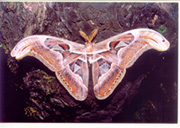Wings of Fantasy
-Shivani Thakur
Usually warning bells are sounded for larger and distinct species of animals.
Smaller and lesser-known species are ignored. In a country of over a billion,
every species of animal and plant is fighting a losing battle.
And if I asked you a question as to when was the last time you saw a butterfly in your garden or a public park, you would draw a blank on your face.
Along with other animals /birds, butterflies are too jostling for space.
India's butterfly population is dwindling fast. And the culprits are humans.
 India has over thousand of species of butterflies.
Among them the Atlas moth of Khasi Hills, Copper Butterfly, Swallowtail, Purple Emperor, Bhutan Glory and Malabar are the exotic and endangered.
The atlas moth is on the brink of extinction. For an insect species that is beautiful, very few know about their role in pollination. According to wildlife conservationist Mike Pandey they are second largest pollinators in the world after the honeybees.
The economic value of pollination by butterflies to agriculture is $ 200 billion dollars per year. A fall in their population can adversely affect agriculture as it has happened in the US.
India has over thousand of species of butterflies.
Among them the Atlas moth of Khasi Hills, Copper Butterfly, Swallowtail, Purple Emperor, Bhutan Glory and Malabar are the exotic and endangered.
The atlas moth is on the brink of extinction. For an insect species that is beautiful, very few know about their role in pollination. According to wildlife conservationist Mike Pandey they are second largest pollinators in the world after the honeybees.
The economic value of pollination by butterflies to agriculture is $ 200 billion dollars per year. A fall in their population can adversely affect agriculture as it has happened in the US.
The major factors responsible for their dwindling population are smuggling, habitat loss and use of pesticides.
The butterfly collectors feed the butterfly smuggling. In the name of farm bred, butterflies are smuggled all over the world to collectors.
They are smuggled in suitcases or envelopes to Japan, Germany, Hong Kong, UK, and Singapore etc. In states like Himachal, N-East states, Uttranchal many a times children are paid Rs 150 per day to catch them.
For every perfect one at least a thousand are thrown away because of damaged wings.
To make matters worse all these deals are done on the Internet making it difficult to trace the offenders.
According to R.S.Prashant butterflies and moths are placed in Schedule I of Wildlife Protection Act of 1972. The absence of cyber laws makes it easier for poachers
to trade.
The use of pesticides like Aldrin, Endosulfan, DDT and Malathion affect butterflies and humans.
Butterflies are fragile insects and any tiny change in their environment reflects on their breeding and growth.
The less use of pesticides and increase in green cover can help their survival. Natural gardens instead of perfect ones can help them immensely.
Smuggling can be stopped if more stringent measures are taken at the time of checking.
A lot of help can come from collectors who instead of framing these exotic species in their drawing rooms let them roam about in their natural environs.
The state governments have started pitching in.
Himachal Pradesh is all set to have a butterfly garden in selected areas like Kufri, Pong wetland and Kullu.
Once the study is completed the project would be handed over to an NGO.
A detailed study of type of plants that are source of food and nectar for insects will be done and encouraged to grow more of those types for their growth.
The annual migration from plains like Haryana, Punjab, Delhi and western UP takes place in spring.
Once there, they feed on nectar of spring flowers and vegetation in the mountains.
With such efforts from the government and people fragile creatures like butterflies can flit freely all over and find a place permanent place in our hearts.
(Photograph of Atlas
Moth By Jayant Deshpande)